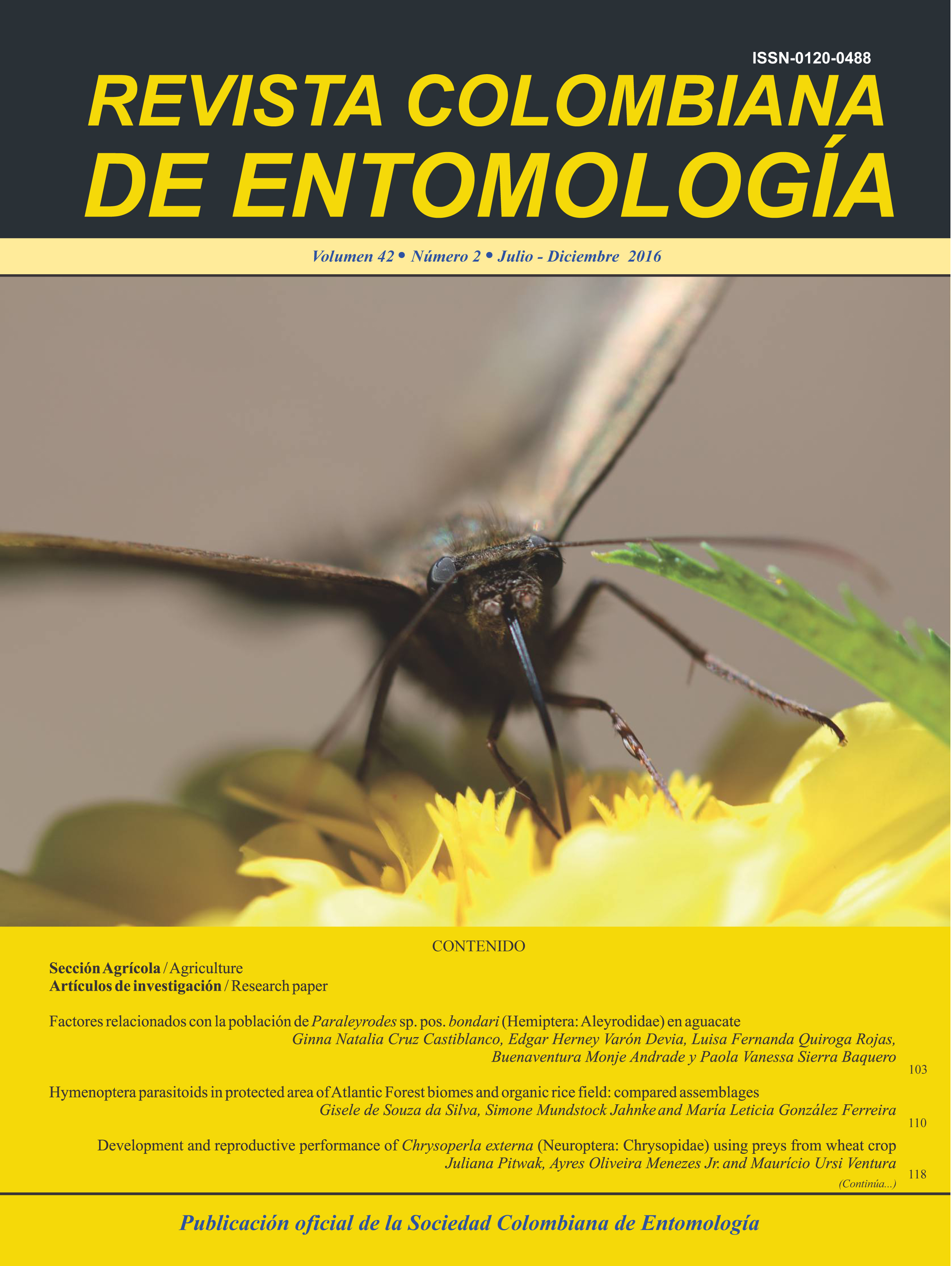Natural enemies of Stenoma cecropia (Lepidoptera: Elachistidae) in oil palm, in the southwest of Colombia
Main Article Content
Stenoma cecropia infests new plantations of hybrid oil palm (Elaeis oleifera x E. guineensis) in Tumaco (Nariño). These infestations are causing defoliation of economic importance to the oil palm. For this reason, the aim of this study was to determine the biotic and abiotic factors affecting populations through fortnightly sequential sampling, following a 2 x 2 moving displacement system, which sampled every two palms and every other line in a one hectare oil palm plantation, counting the number of live and dead individuals present in the 17th and 25th S. cecropia leaves of each palm evaluated. Results indicate that S. cecropia is attacked by a variety of predators, parasitoids and entomopathogens. Among the former are the spiders (Araneae), bugs (Reduviidae), wasps (Vespidae), and ants (Formicidae), with Crematogaster being the most important. Among the parasitoids, Brachymeria sp. and Rhysipolis sp. were most abundant. These species require the nectar of plants such as Melanthera aspera, Solanum quitoense, Emilia sonchifolia, Lantana camera, Cassia reticulata, Stachytarpheta cayennensis and Urena lobata, for food until the adult stage. An entomopathogenic fungus was also detected infecting the larval stage and was identified as Isaria sp. Crematogaster sp. predation on larval stages of S. cecropia was estimated to be 42 %. Parasitism by Brachymeria sp. In pupal stages was 16.8 %, mortality caused by Rhysipolis sp. on larval stages was 3.5 % and mortality by Isaria sp. Was 1.5 %. It is concluded that these biological control agents are important in the regulation of S. cecropia populations in oil palm plantations in Colombia.
- Carlos Enrique Barrios-Trilleras, Natalia Julieth Castillo-Villarraga, Alex Enrique Bustillo-Pardey, Charles L. Staines, New records of Cephaloleia (Coleoptera: Chrysomelidae) pest of oil palm in Colombia , Revista Colombiana de Entomología: Vol. 46 No. 1 (2020)
- ALEX ENRIQUE BUSTILLO-PARDEY, A review of the coffee berry borer, Hypothenemus hampei (Coleoptera: Curculionidae: Scolytinae), in Colombia , Revista Colombiana de Entomología: Vol. 32 No. 2 (2006)
- INDHIRA CRISTINA REYES-ARISTIZÁBAL, ALEX ENRIQUE BUSTILLO-PARDEY, BERNARDO CHAVES-CÓRDOBA, Effect of Beauveria bassiana and Metarhizium anisopliae on the coffee berry borer parasitoid Cephalonomia stephanoderis , Revista Colombiana de Entomología: Vol. 21 No. 4 (1995)
- ALEX ENRIQUE BUSTILLO-PARDEY, Evaluation of chemical and biological insecticides to control Frankliniella occidentalis (Thysanoptera: Thripidae) in asparagus crops , Revista Colombiana de Entomología: Vol. 35 No. 1 (2009)
- VIVIANA LUCÍA CUARÁN, ULISES CASTRO-VALDERRAMA, ALEX ENRIQUE BUSTILLO-PARDEY, NORA CRISTINA MESA-COBO, GERSON DARÍO RAMÍREZ-SÁNCHEZ, CARLOS ARTURO MORENO-GIL, LUIS ANTONIO GÓMEZ-LAVERDE, Method to evaluate spittlebug (Hemiptera: Cercopidae) damage on sugar cane Saccharum spp. , Revista Colombiana de Entomología: Vol. 38 No. 2 (2012)
- MIRIAM ROSERO-GUERRERO, ALEX ENRIQUE BUSTILLO-PARDEY, JUAN CARLOS LÓPEZ-NÚÑEZ, ULISES CASTRO-VALDERRAMA, EYDER DANIEL GÓMEZ-LÓPEZ, Efficiency of entomonematodes for controlling Aeneolamia varia (Hemiptera: Cercopidae) stages under controlled conditions , Revista Colombiana de Entomología: Vol. 38 No. 2 (2012)
- CARLOS ANDRÉS MORENO-SALGUERO, ALEX ENRIQUE BUSTILLO-PARDEY, JUAN CARLOS LÓPEZ-NÚÑEZ, ULISES CASTRO-VALDERRAMA, GERSON DARÍO RAMÍREZ-SÁNCHEZ, Virulence of entomopathogenic nematodes to control Aeneolamia varia (Hemiptera: Cercopidae) in sugarcane , Revista Colombiana de Entomología: Vol. 38 No. 2 (2012)

This work is licensed under a Creative Commons Attribution-NonCommercial-ShareAlike 4.0 International License.
Authors retain the copyright on their work and are responsible for the ideas expressed in them. Once a manuscript is approved for publication, authors are asked for a publication license for the term of legal protection, for all territories that allows the use, dissemination and disclosure of the same.





